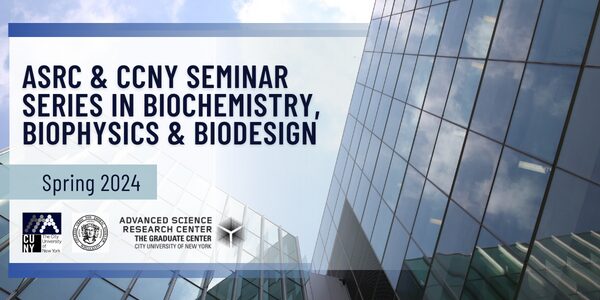
ASRC – City College of New York Seminar in Biochemistry, Biophysics & Biodesign
SEMINAR LOCATION:
ASRC Main Auditorium, 85 Saint Nicholas Terrace
The speaker will be giving this talk online, viewable in the ASRC Main Auditorium. Non-CUNY attendees need to register in advance; please see details below.*
THIS SEMINAR MAY ALSO BE VIEWED REMOTELY VIA ZOOM:
https://gc-cuny.zoom.us/j/91637964386
Meeting ID: 916 3796 4386
Passcode: asrc+ccny
V(D)J recombination in the 3D nucleus of pro-B cells
Abstract Progenitor B cells in the bone marrow develop a diverse antibody receptor repertoire to provide protection against a wide range of antigens and pathogens in the periphery. Each mature B cell has a unique Ig receptor, created via V(D)J recombination through an ordered set of rearrangements. One of the ~100 functional Igh locus VH genes, spread over 2.4 Mb must recombine with a rearranged DJH element, which is itself assembled from one of 8-12 DH and one of 4 JH gene segments in each pro-B cell. V gene rearrangement occurs at very different intrinsic frequencies, yielding only quasi-random Igh repertoires in pro-B cells. Examination of V germline transcript expression, accessibility, transcription factor (TF) binding, RSS quality, and the epigenetic landscape has shown that no single- or combination of variables accounts for unequal V gene usage and has left unresolved the mechanism regulating V gene choice. V(D)J recombination efficiency is predicated on two defining features of the locus in chromatin. First, the Igh locus undergoes chromatin contraction in primary pro-B cells as detected by 3D DNA fluorescence in situ hybridization (FISH) analyses and chromatin conformation capture (3C)-based studies, and this is mediated by cohesin mediated loop extrusion. Absence of contraction leads to loss of V->DJ rearrangement among the distal VH genes. Second, radial repositioning of the Igh locus from the repressive nuclear lamina to locations in the nuclear center is correlated with effective locus function in pro-B cells. We have deleted a highly transcribed VH gene, located in Igh Site I, in mice and find altered VH gene usage, reduced V->DJ rearrangements and Ig gene transcription suggesting an overall impairment of Igh locus function. However, we also observed increased locus contraction that is positively associated with locus function. To reconcile these findings, we examined radial position of the Igh locus by 3D DNA FISH and found that the Site I VH gene deleted locus failed to locate to the nuclear center, exhibited aberrant chromatin conformation and displayed increased H3K27ac modifications indicating dysfunction at multiple levels. Strikingly, we also found that the Igh locus associates with nuclear speckles in the nuclear center using a combination of DNA FISH and immuno-FISH. The Igh locus, deleted for the Site I VH gene fails to associate with nuclear speckles and drifts towards the nuclear periphery. Loss of tethering to nuclear speckles by deletion of a highly transcribed VH gene indicates that radial positioning of the Igh locus in the 3D nuclear space is an active process that orchestrates a number of features associated with Igh locus function including V(D)J recombination.
* Dr. Kenter will be giving this talk via Zoom. Participants have the option to view either online or from the ASRC Main Auditorium. For non-CUNY attendees: advance registration is required; please contact Hyacinth Camillieri at hcamillieri@gc.cuny.edu no later than Monday, March 11th for entry to the ASRC.
Download the flyer for this event here:
See the complete speaker schedule for this seminar series here:

